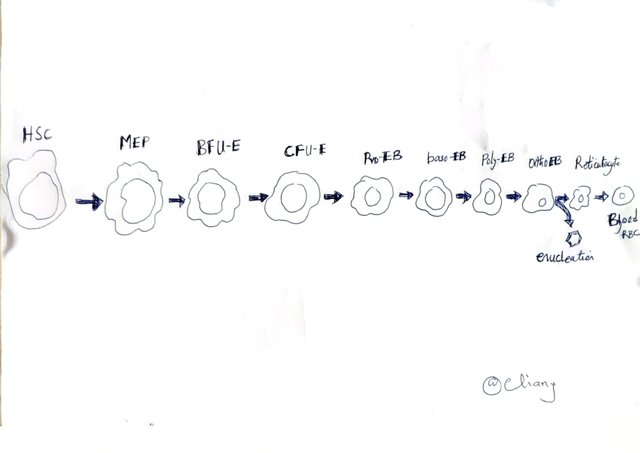SEC S20W4 || Ethiopathogenic Anemias - Module 4

It interest me ta take part in this week hematology class, after reading the module and researching, I decided to take part in the homework task.
I present my task as follows
To define Etiopathogenic Anemia, let me break down the meaning of this medical terms to my understanding and that of my readers.
"Etio" is a Greek word which means "causation or causes"
"Pathogenic" is a medical term which describes any diseases in humans.
"Anemia" simply means low level of RBC in the body
From the above breakdown, I can say that Etiopathogenic is referred to the disease which causes Anemia.
Therefore, Etiopathogenic anemia is a disease condition that is caused by fluctuation in the production of the RBC and their release into the peripheral blood due to either ineffective or deficient (imbalance) of hemoglobin.
In most cases, bone marrow produces immature RBC other than normal then released it into the peripheral blood where the RBC mature within 1 to 2 days some do refuses to mature while others may likely be destroyed. So during blood test, when there is an increase or decrease in reticulocyte count, know that it indicate failure which is likely to be either the RBC are being destroyed more faster than what the body can replace or bone marrow dysfunction. E.g of this disease include hemolytic anemia, Polychromasia
Hemolytic anemia: is a blood disorder that happens when the red blood cells are prematurely destroyed faster than their normal life span. Normally, RBC live span is 120 days, so when they break down or die earlier than this 120 days, the bone marrow is deprived of enough time to produce enough new RBC which will results in low red blood cell for organs, tissues to get enough oxygen as they needed.
Severe blood loss: in this case, both internal or external bleeding causes the bone marrow to slow down RBC level production.
Cancer: some type of cancers can invade the bone marrow, causes interference in red blood cell production or forces blood cells out prematurely into the bloodstream
Treatment always depends on the underlying condition causing the disorder.

HSC - Hematopoetic stem cell
MEP megakaryocyteerythrocyte progenitors (myeloid stem cell)
BFU-E - burst-forming unit
CFU-E colony- forming unit E
pro-EB - pro erythroblast
baso-EB - basophilic erythroblast
poly-EB - polychromatic erythroblast
ortho-EB - orthochromatic erythroblast
Reticulocytes
Matured RBC
With the acronym I've interpreted, the diagram is simple and understandable.
Last week, we learned that the classification of Anemia is from three main points which are important to serve as a guide in diagnosis they includes;
- Pathogenesis.
- RBC morphology
- Clinical presentation.
The morphology was explained of which we were told that pathology is broad.
| Regenerative | Hypo-regenerative |
|---|---|
| Bone marrow respond approximately to low RBC mass and increased production of erythrocytes | Inadequate response to the increase need of RBC by bone marrow. |
| Increase production of reticulocytes | little production of reticulocytes, |
| Caused by either an increased breakdown of the RBC known as haemolysis or by blood loss eg, from bleeding excessively | Caused by an underlying condition in the bone marrow which interfere with the normal production of RBC. |
Incases of bleeding, do not panic, get yourself or the person bleeding to the hospital immediately for possible intervention and they will also check for the causes of bleeding.
First on arrival in the hospital, some necessary check will be carried out such as the person vital signs then further checks to see the cause of the bleeding, and where the bleeding is coming from then some medications will be given to stop the bleeding e.g Inj. Vitamin k which helps in clotting blood vessels while blood sample will be taken to do peripheral blood smear so as to know if the patient is suffering from a regenerative or non-regenerative anemia.
So from the test, if reticulocytes are present, with IPR of 1% to 2%, the patient has a non-regenerative type of anemia. But if the IPR is above 3%, then the patient is suffering from a regenerative type of anemia.
In this case, further medical investigation is required so as to care for the patient effectively.
Then a complete hematology test will be carried out to indicate the hemoglobin level, so as to know what is remaining and how to build the blood level quickly.
I will like to invite @dequeen @nancy0 @skinnyblack to take part in this contest

Thank you @anailuj1992
Your informative post about anemia is amazing! Your contribution in raising health awareness is truly appreciated. Good luck for the contest.
Wow that's great 😃
I appreciate your kind comment
Hi! Your diagram looks very simple and easy to understand, at the beginning of the course it was difficult for me to understand the erythrocyte maturation process, but now it is easier and I can see it in your diagram.
I didn't know that there were types of cancer that could cause anemia, this is good information that I will keep in my brain for the future.
Have a nice day!